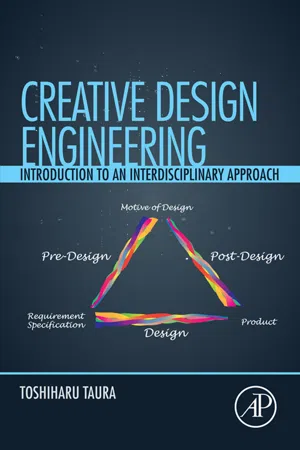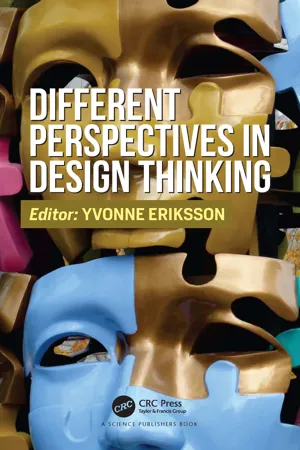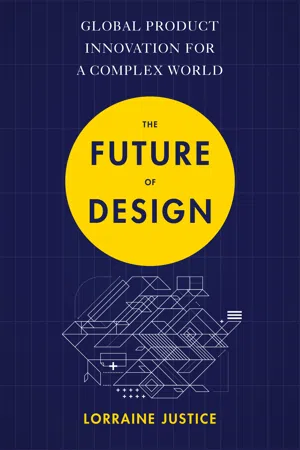Design Engineering
Design engineering involves the application of scientific and engineering principles to the creation of products, systems, and processes. It encompasses the entire design process, from conceptualization and planning to prototyping and testing. Design engineers use their expertise to develop innovative solutions that meet specific requirements and address real-world challenges.
7 Key excerpts on "Design Engineering"
- eBook - ePub
Engineering Textiles
Integrating the Design and Manufacture of Textile Products
- Yehia Elmogahzy(Author)
- 2019(Publication Date)
- Woodhead Publishing(Publisher)
...The operating system for these interactions is engineering design. 4.2 Definition of engineering design The Accreditation Board for Engineering and Technology (ABET) in its 2015–16 report titled Criteria for Accrediting Engineering programs (https://www.abet.org/) defines engineering design as “the process of devising a system, component, or process to meet desired needs. It is a decision-making process (often iterative), in which the basic sciences, mathematics, and the engineering sciences are applied to convert resources optimally to meet these stated needs.” ABET also indicates that among the fundamental elements of the design process are the establishment of objectives and criteria, synthesis, analysis, construction, testing, and evaluation. The earlier definition is adopted by virtually all engineering programs in the United States irrespective of the engineering education discipline. It does not reflect a typical design process, but rather point out some of the key elements of design that are commonly considered. On the other hand, it leaves many design aspects open for interpretation. For example, the term “desired needs” in this definition does not imply if these needs stem from a designer's viewpoint or a user's viewpoint, which may be completely different things. The use of the term “decision-making” may also be somewhat confusing since it does not apply to the approval of a product model being designed by the product developer, which is the key decision, but rather to the acceptance of a model by the engineers who developed it. Perhaps, the most critical term missing in the ABET definition are “problem-solving” and “uncertainty.” A typical engineer spends most of his/her time concerned with problems and their potential solutions. Because engineers often create incredible things, many people outside the field think that engineers normally think big; it is often the opposite...
- eBook - ePub
Science in Design
Solidifying Design with Science and Technology
- Tarun Grover, Mugdha Thareja(Authors)
- 2020(Publication Date)
- CRC Press(Publisher)
...1 General Aspects of Science, Design, and Engineering 1.1 What Is Design? A design is a strategy or specification for the development of a system or object. In other words, design can be thought of as the implementation of a plan or a process to achieve an objective. More often, the term “design” is used to indicate the outcome of a process or strategy in the form of a prototype or a final product. The broader meaning of design can be interpreted more easily with the following narration. Undoubtedly, the term “design” encompasses the varying viewpoints of people who understand its meaning through different lenses. In general, “design” is the process of visualizing and planning the development of systems, objects, methods, products, etc. The definition of design is versatile and artful, and design has taken many shapes and forms based on multidisciplinary concepts. Besides the major cluster of design disciplines (engineering, information systems, industrial, architecture, textile, and fashion), experience design, service design, and interactive design have evolved as new domains for design enthusiasts to explore deeper insights. 1.1.1 Definition of Design First, let’s glance at some of the noteworthy definitions of design by well-known authors. A design is a plan to make something new for people that they perceive as beneficial. – Koss Looijesteijn Design is a reflective conversation with the materials of a design solution. – Donald A. Schön It’s the difference between your favourite and least favourite thing you use. – Scott Berkum Design is its own culture of inquiry and action. – Harold Nelson, Erik Stolterman Having these in mind, the ability to design and the notion of design relating its associative aspects are the key focus in conceiving the definition of the term “design”...
- Paul Mac Berthouex, Linfield C. Brown(Authors)
- 2021(Publication Date)
- CRC Press(Publisher)
...2 Defining the Engineering Problem Design is most often used to mean the conception and preparation of detailed written and graphical descriptions of all the system components. It is more than that. Important design decisions are made long before detailed drawings are prepared. In some projects there are no drawings at all. The design might be a better way of financing bonds, a new way of scheduling waste hauling, or improved instructions for operating and maintaining pumps or motors. Every design problem will involve answering these questions: What problem needs to be solved? What alternative designs can reasonably be expected to solve the problem? What is the cost of each technically feasible alternative? Which is the best solution for implementation? Sometimes non-technical and non-monetary factors are identified and evaluated for each alternative. Such factors are system reliability, worker safety, esthetics and public relations, flexibility and ease of operation, constructability, compatibility with existing systems, and ease of expansion. 2.1 The Stages of Design Figures 2.1 and 2.2 show that creative decisions are made early in the design process. As the work moves toward detailed drawings and specifications, the opportunity for conceptual innovation is diminished. The accumulating volume of detailed information consumes the design effort. FIGURE 2.1 The early stages of design are when innovation occurs. FIGURE 2.2 Stages of design and construction. 2.2 Identifying the Problem The systematic solution of an engineering problem follows a logical process that is no different from that which everyone should follow in conscious everyday reasoning. It does differ, however, from casual judgments that lack a thorough and impartial pursuit of fact and data...
- eBook - ePub
- Clifford Matthews(Author)
- 2011(Publication Date)
- Wiley-Blackwell(Publisher)
...A group of minds can form a richer picture of a problem than can one. Remember the golden rule: decide what type of problem you are looking at before you try to solve it. 3.3 Design Principles Engineering design is a complex activity. It is often iterative, involving going back on old ideas until the best solution presents itself. There are, however, five well-proven principles of functional design that should be considered during the design process of any engineering product. Clarity of function This means that every function in a design should be achieved in a clear and simple way, i.e. without redundant components or excessive complexity. The principle of uniformity Good functional design encourages uniformity of component sizes and sections. Any variety that is introduced should be there for a reason. Short force paths It is always best to keep force paths short and direct. This reduces bending stresses and saves material. Local closure (in which forces cancel each other out) is also desirable – it reduces the number of ‘wasted’ components in a design. Least constraint This is the principle of letting components ‘go free’ if at all possible. It reduces stresses due to thermal expansions and unavoidable distortions. Use elastic design Good elastic design avoids ‘competition’ between rigid components which can cause distortion and stresses. The idea is to allow components to distort in a natural way, if that is their function. 3.4 The Engineering Design Process The process of engineering design is a complex and interrelated set of activities. Much has been written about how the design process works both in theory and in practice. There is general consensus that: • Scientific principles + Design is the use of: • Technical information + • Imagination Designs are hardly ever permanent. All products around us change – sometimes gradually and sometimes in major noticeable steps – so the design process is also continuous...
- eBook - ePub
Creative Design Engineering
Introduction to an Interdisciplinary Approach
- Toshiharu Taura(Author)
- 2016(Publication Date)
- Academic Press(Publisher)
...For example, gasoline-powered cars provide users with the convenience of transportation, while they receive demands from users for new functions, such as high fuel efficiency. The relations shown in Fig. 1.1 also help us to understand the difference between engineering design and industrial design. Whereas engineering design is closer to science and technology, in the sense that it relies on a fundamental knowledge of physical phenomena, industrial design is closer to society, in the sense that the focus is on relations with consumers (Fig. 1.2). Figure 1.2 Engineering design and industrial design. 1.2. Perspectives on design: analytical and synthetic methods This book uses the term “design” in the broad sense, encompassing engineering design and industrial design. The word “design” can be used in different ways. For example, “I like the design of that chair,” “This event is well designed,” or “Let’s design a vision for the company.” In each of these sentences, “design” expresses a different meaning. In the first, it refers to an esthetic appreciation, in the sense of giving color and shape to products. In the second, it refers to structure and order, in the sense of orchestrating a plan to achieve a goal. In the third, it refers to drawing a vision for the future, in the sense of pursuing an ideal image. In this book, we will focus on the second and third meanings. Design methods can largely be classified into two types. The first method is primarily used when there is an explicit problem. A problem usually refers to the gap between an existing situation and a goal. In this book, we use it to refer to such a gap in relation to a specific product or how it is used. The key here lies in analyzing the goal and the existing situation. In this book, the term analysis means understanding the nature of something that already exists by breaking it down into several parts or constituent characteristics...
- eBook - ePub
- Yvonne Eriksson, Yvonne Eriksson(Authors)
- 2022(Publication Date)
- CRC Press(Publisher)
...The evolution in design paradigms, from user-oriented to participatory, accompanied changes in the way we perceive the roles of engineers, designers and users, placing new demands on engineering education for product developers. Considerations on engineering education should include two things: First, all engineering education is the result of educators and their framing of good engineering, forming the basis of curricula, courses, pedagogy, and educational models. Second, student’s perception of engineering design rests on these frames, influencing them in becoming a Design Engineering professional. Prior to starting their education program, most students miss a clear perception of engineering in general and the particular design philosophy they are subscribing to, meaning preferences towards specific perceptions of engineering design are set by their choice of school. Identity development as a professional starts as soon as students enrol into an undergraduate engineering program, gradually developing an authorized understanding of engineering, and learning to meet prescribed standards. Overcoming the conservative engineering approach of solely thinking of technical solutions, design thinking is to be understood as an innovation or entrepreneurship craft offering a toolkit, which needs to be taught and trained well in order to being pursued successfully. The continuously increasing number of courses and programs each of varying style and format, aimed at qualifying professionals and non-professionals with any background in design thinking, proves an existing educational need. High quality training formats aiming at actually stimulating and establishing sustainable change in one’s design thinking behaviour are expensive and time-consuming...
- eBook - ePub
The Future of Design
Global Product Innovation for a Complex World
- Lorraine Justice(Author)
- 2019(Publication Date)
- Nicholas Brealey Publishing(Publisher)
...CHAPTER 3 The Design Process, Design Thinking, and Innovation Creative Problem Solving There are many paths to creative problem solving, which takes place in every area of study. The arts, business, humanities, and sciences have their own methods, processes, and terminologies that have evolved with each those disciplines. Around the world, today’s artists, scientists, businesspeople, and other professionals engage in creative problem solving, but not necessarily within a design process. A computer programmer may try to solve issues with a difficult piece of code but may not be a part of a larger design process. A biomedical engineer working in her lab may try to find a cure for a disease, but she may not be involved in a wider design process. In some cases, an innovator’s own interests and passions lead them through their own creative problem-solving process, which may be different from the design process. Even though the design fields are fairly young in comparison to other creative disciplines such as art and architecture, I include design under the umbrella of creative problem solving. The field of design was first inspired by arts and crafts methods. Initially, design was artistic and intuitive and did not involve solving major problems, other than to make a desirable and functional object. Now, design, inspired by science and technology, has taken on much more complex problems to solve. Even a simple problem in the past, such as making a functional tool, has grown to be more than just the tool. It represents a brand, it may have technology embedded, it must be safe, it must meet legal requirements, and be made of durable but sustainable materials. The simple act of making coffee with an electric coffee pot has grown more complex over the years...






